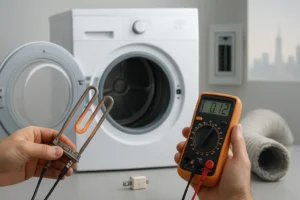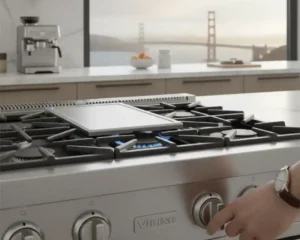A comprehensive freezer maintenance guide ensures your appliance runs efficiently, saves energy, and lasts for years. By following simple, proactive steps, you can prevent costly repairs and keep your food perfectly preserved. This guide covers 10 essential tips, including temperature management, regular cleaning, door seal care, and more, to help you maintain your freezer like a pro.
Detailed Freezer Maintenance Guide
1. Set and Monitor the Ideal Freezer Temperature
Maintaining the correct temperature is critical for food safety and energy efficiency.
- Optimal Range: Keep your freezer at 0°F (-18°C) to preserve food quality and prevent bacterial growth.
- Use a Thermometer: Place an appliance thermometer inside to regularly check the temperature, ensuring it stays consistent.
- Adjust Seasonally: In warmer months, slight adjustments may be needed to compensate for ambient heat, especially in garages or basements.
- Avoid Overloading: Overpacking can block air circulation, causing temperature fluctuations—leave space for air to flow.
2. Clean the Freezer Regularly
Regular cleaning prevents odors, maintains hygiene, and ensures efficient operation.
- Defrost Manual Freezers: For non-frost-free models, defrost every 6 months or when frost buildup exceeds ¼ inch to maintain cooling efficiency.
- Wipe Interior Surfaces: Use a solution of warm water and mild dish soap to clean shelves and walls, avoiding harsh chemicals that can damage surfaces.
- Clean Exterior and Coils: Dust condenser coils every 6–12 months with a vacuum or coil brush to improve heat dissipation and energy efficiency.
- Sanitize Door Handles: Wipe handles with a disinfectant to eliminate germs, especially in high-traffic kitchens.
3. Inspect and Maintain Door Seals
A tight door seal prevents warm air from entering, reducing energy waste and strain on the compressor.
- Check for Leaks: Close the door on a piece of paper; if it slides out easily, the seal may need cleaning or replacement.
- Clean Seals Regularly: Use warm, soapy water to remove dirt or sticky residues from gaskets, ensuring a proper seal.
- Replace Damaged Seals: If seals are cracked or warped, replace them promptly to maintain efficiency and prevent frost buildup.
- Test Door Alignment: Ensure the door closes fully without gaps, adjusting hinges if necessary to maintain a tight seal.
4. Organize Freezer Contents for Efficiency
Proper organization optimizes space, improves airflow, and reduces energy consumption.
- Use Clear Containers: Store food in labeled, transparent containers or bags to quickly locate items and minimize door-open time.
- Rotate Stock: Place older items at the front to use them first, preventing food waste and maintaining inventory freshness.
- Avoid Overcrowding: Leave space between items to allow cold air to circulate, ensuring consistent freezing temperatures.
- Group Similar Items: Keep meats, vegetables, and prepared meals in designated zones for easy access and better organization.
5. Defrost and Manage Ice Buildup
Excess ice reduces storage space and forces the freezer to work harder, increasing energy costs.
- Schedule Regular Defrosting: For manual-defrost freezers, unplug and empty the unit, letting ice melt naturally or using warm water to speed up the process.
- Check Auto-Defrost Systems: For frost-free models, ensure the defrost cycle works properly; listen for unusual noises that may indicate issues.
- Remove Spills Immediately: Clean up spills or leaks to prevent them from freezing and causing ice buildup or damage.
- Use a Scraper: Gently remove stubborn ice with a plastic scraper, avoiding sharp tools that could puncture the freezer lining.
6. Maintain Proper Ventilation Around the Freezer
Adequate ventilation prevents overheating and ensures optimal performance.
- Provide Clearance Space: Leave at least 2–3 inches of space around the freezer, especially near vents and coils, to allow proper airflow.
- Avoid Heat Sources: Place the freezer away from ovens, radiators, or direct sunlight to reduce strain on the cooling system.
- Clean Vents Regularly: Remove dust or debris from vents to maintain airflow and prevent compressor overheating.
- Check Placement: Ensure the freezer is on a level surface to avoid vibrations that could affect performance or alignment.
7. Schedule Professional Maintenance
Regular professional checkups can catch issues early and extend your freezer’s lifespan.
- Annual Inspections: Schedule a technician to inspect the compressor, coils, and electrical components every 12–18 months.
- Address Unusual Noises: Humming, buzzing, or clicking sounds may indicate mechanical issues—call a professional promptly.
- Check Refrigerant Levels: Low refrigerant can reduce cooling efficiency; a technician can check and recharge if needed.
- Calibrate Controls: Ensure temperature controls and thermostats are accurate to avoid overcooling or undercooling.
8. Monitor Power Supply and Electrical Components
A stable power supply protects your freezer from damage and ensures consistent performance.
- Use a Surge Protector: Plug the freezer into a surge protector to safeguard against power surges or electrical spikes.
- Check the Power Cord: Inspect the cord for fraying or damage, replacing it if necessary to prevent electrical hazards.
- Avoid Extension Cords: Plug the freezer directly into a dedicated outlet to ensure stable voltage and avoid overloading circuits.
- Test GFCI Outlets: If your freezer is in a garage or basement, ensure the outlet is ground-fault circuit interrupter (GFCI) protected for safety.
9. Manage Food Storage to Prevent Overload
Proper food storage reduces strain on the freezer and maintains food quality.
- Cool Food Before Storing: Let hot or warm food cool to room temperature before placing it in the freezer to avoid raising internal temperatures.
- Use Proper Packaging: Wrap food tightly in freezer-safe bags or containers to prevent freezer burn and maintain quality.
- Limit Door Openings: Minimize how often and how long the door is open to maintain consistent temperatures and reduce compressor workload.
- Track Inventory: Keep an inventory list to avoid overloading and ensure you’re using food before it expires.
10. Recognize and Address Warning Signs Early
Early detection of issues can prevent costly repairs and food spoilage.
- Monitor Temperature Spikes: If the freezer struggles to maintain 0°F, check for blocked vents, dirty coils, or door seal issues.
- Watch for Frost Buildup: Excessive frost in frost-free models may indicate a faulty defrost system—contact a technician.
- Listen for Noises: Persistent rattling or grinding sounds could signal compressor or fan issues, requiring professional attention.
- Check for Leaks: Puddles or moisture around the freezer may indicate a clogged drain or failing seal—address immediately.
Conclusion
By following these 10 essential freezer maintenance tips, you can ensure your appliance runs efficiently, saves energy, and enjoys a longer lifespan. Regular cleaning, proper temperature management, and timely professional servicing prevent breakdowns and costly repairs. Organized storage and vigilant monitoring reduce food waste and maintain quality. Implementing this guide will keep your freezer in top shape, saving you money and hassle while keeping your food perfectly preserved.
Need Professional Freezer Repair?
If your freezer shows signs of malfunction, such as unusual noises or temperature issues, don’t wait for the problem to worsen. Our expert freezer repair services can diagnose and fix issues quickly, ensuring your appliance runs smoothly. Contact us today for reliable, professional care!






